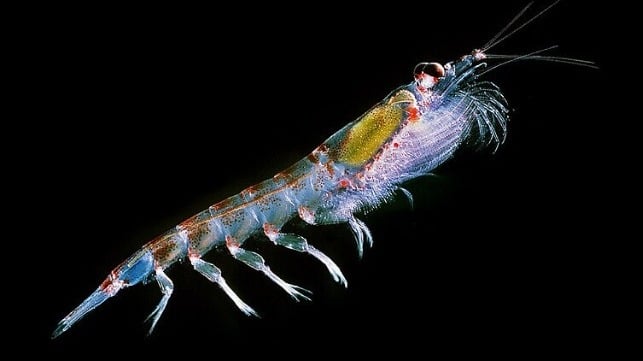Antarctic Krill Store an Astonishing Amount of CO2 in the Deep Ocean

[By Angus Atkinson, Anna Belcher and Emma Cavan]
Antarctic krill – shrimp-like crustaceans that inhabit the icy waters surrounding Antarctica – may be small (around 5cm) but they have an enormous total biomass, similar to that of the global human population. However, while humans pump ever more carbon into the atmosphere, krill are working in reverse. They are nature’s heroes, helping to transport carbon out of the atmosphere and store it deep inside the ocean.
Krill are best known for the key role they play in Southern Ocean ecosystems. They are central in its unique food web, linking the energy fixed by microscopic marine plants called phytoplankton to a wide range of iconic species including penguins, seals, whales, fish and squid. Krill are also fished commercially, and this major industry is valued at around US$0.3 billion per year.
Not only are they important for the food web and fisheries, our recent study finds they store at least 20 million tonnes of carbon in the deep ocean annually, equating to US$4-46 billion depending on the price of carbon. (By converting estimates of carbon sequestration to dollar values, our study enables a better comparison with other marine environments.)
This krill-driven store in the Southern Ocean is similar in tonnage to the blue carbon stored globally within habitats such as mangroves, saltmarshes and seagrasses. But while krill are valuable in storing carbon, they are also victims of the warming climate, warranting protection alongside these other coastal ecosystems.
Marine plankton such as krill eat microscopic plants to provide the energy they need. But the carbon they don’t use (their poo and other waste products) sinks to the deep ocean, locking it up for hundreds of years.
Krill are super-efficient in this carbon storage because they are much larger than most other plankton and produce large, rapidly sinking faecal pellets. They occur in huge numbers and form dense swarms.
Combined, this causes a carbon superhighway to the deep ocean, through “rain showers” of faecal pellets which sink much faster than carbon trapped in other forms of decaying phytoplankton and debris. Though the swarming nature of krill facilitates this superhighway for carbon, it also makes it difficult to measure just how many krill there are in the Southern Ocean.
Krill act as a carbon store – this film explains how.
Krill swarms are patchy and vary from huge, densely packed “superswarms”, which can be over a kilometre in length, to small diffuse swarms less than 50 metres long. This means that most krill reside in a relatively small number of swarms, making them tricky to quantify.
In our study, we combined a large Antarctic database of krill density, estimates of the carbon in their waste products, and knowledge of how these sink and decay to calculate how much krill-driven carbon gets stored deeper in the ocean.
For the first time, we used a computer model of ocean currents to show these waste products don’t need to reach great depths to achieve storage for at least 100 years, further enhancing the carbon storage potential of krill habitats.
Together, this makes carbon storage from krill equivalent to that of coastal ecosystems featuring mangroves, salt marshes and seagrass. Known as “blue carbon” habitats, these are already valued for their biodiversity and as hotspots of carbon storage.
In contrast, animals such as krill and their ocean habitats are not regularly framed in this blue carbon context. The comparisons provided by our study emphasise the need for a new dialogue in management and conservation of the Southern Ocean. Rather than just considering krill in terms of their value to fisheries, we need to take into account the conservation potential of krill habitats, including their role in carbon storage.
Hope in the high seas
The UN’s recent High Seas Treaty, aimed at conserving biodiversity in areas beyond national jurisdiction, offers some hope for progress. It mentions the need to preserve the ability of large oceanic ecosystems to cycle and store carbon, and nowhere is this need clearer than in the Southern Ocean.
While krill may be heroes of carbon storage, they are also victims of rapid warming and ice loss as our planet warms. This warming has squeezed their suitable habitat into ever smaller areas, and while we do not fully understand the consequences of further warming, the prevailing view among scientists is that it is likely to get worse for krill. In future, they may be replaced by other carbon-storing species – but it is hard to imagine one that does it better than krill.
There could be a positive ending to this story, however. Fishery managers, scientists, conservation groups and the krill fishing industry are working increasingly effectively together. There is still a long way to go with this, but at least they are funding research that is improving management and conservation of these cherished ecosystems.
Angus Atkinson is a Professor of Marine Ecology at Plymouth Marine Laboratory.
Anna Belcher is a Catchment Biogeochemist, UK Centre for Ecology & Hydrology.
Emma Cavan is a Senior Lecturer, Department of Life Sciences, Imperial College London.
This article appears courtesy of The Conversation and may be found in its original form here.
Top image: Uwe Kils / CC BY SA 3.0

The opinions expressed herein are the author's and not necessarily those of The Maritime Executive.
